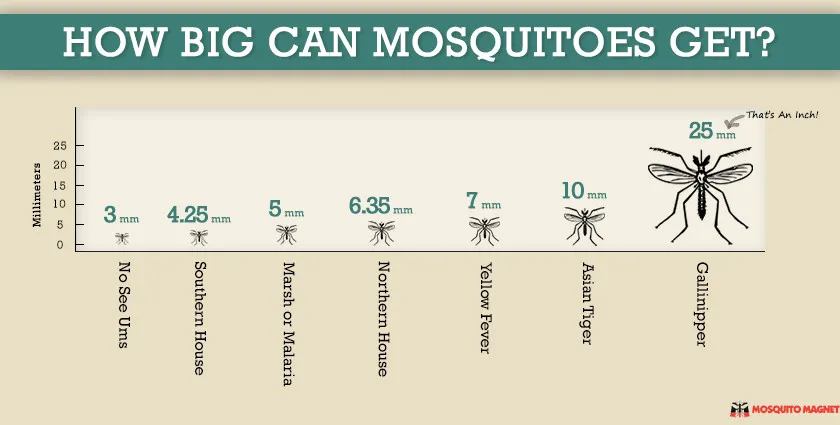How Big Can Mosquitoes Get?
How Big Can Mosquitoes Get? A size comparison of mosquitoes and midges. Mosquitoes and midges are pests, tiny little pests, yet they’re the most deadly animal on the planet. Here at Mosquito Magnet®, we wanted to take a look at the size difference between some of the most common biting mosquitoes and midges. In our infographic below, you can find a comparison of size between the smallest of these blood suckers – the biting midge, to the largest of them all – the gallinipper mosquito.
Biting Midges/No-See-Ums/Punkies/Sand Flies
Biting midges range in body length from 1 – 4mm (0.04 – 0.16in) These tiny pests are often so small that they can fit through typical screens on windows and doors. In tropical regions, biting midges are known to transmit filarial worms to humans and bluetongue virus to livestock. However, even when these pests aren’t vectors (carriers) of disease, their bite can be extremely uncomfortable and some people may develop an allergic reaction. On the plus-side, No-See-Ums and Gull Midges are the only known pollinators of the cacao tree. There are 4,000 – 5,000 known species of biting midges located throughout the world in tropical, sub-tropical, sub-Saharan, temperate regions and even areas with cooler climates.
Southern House Mosquito/Culex quinquefasciatus
The Southern House Mosquito ranges in length from about 3.96-4.25mm (0.16 – 0.17in). These opportunistic nighttime feeders are known to transmit West Nile Virus, Western Equine Encephalitis, St. Louis Encephalitis, Rift Valley Fever Virus and filarial nematode. The Southern house mosquito, aptly named, enters homes at dusk to feed and rest on walls and in clothing. Mature females of the species prefer human blood. Quinquefasciatus is Latin for five-banded, referring to the banded appearance of the mosquito. Culex quinquefasciatus is a sub-tropical species found in North and South America, Australia, Asia, Africa, the Middle East and New Zealand within latitudes 36°N and 36°S.
Malaria Mosquito/Anopheles Mosquito/Marsh Mosquito
Known universally as the Malaria Mosquito, the Anopheles is the primary vector for Malaria. It is typically about 5mm (0.20in) in length and, uniquely, points its stomach upward while sitting. Anopheles mosquitoes are also known transmitters of heartworm in dogs. Approximately 430 species of Anopheles mosquitoes exist, but only 30 – 40 of those species are vectors of malaria. Many of the vector species of this mosquito have become resistant to insecticides. Anopheles mosquitoes are found all throughout the world, with the exception of Antarctica.
Northern House Mosquito/Culex pipiens
Ranging in length from 3 – 7mm (0.12 – 0.27in), the Northern House Mosquito is known as the primary vector of St. Louis Encephalitis. This mosquito also transmits West Nile Virus, Western Equine Encephalitis, Heartworm in dogs and bird Malaria. Previously considered a “bird feeder,” this mosquito has gotten the taste for human and mammal blood. The female C. pipiens is known to overwinter in caves, cellars, basements and outbuildings. This mosquito is considered to be the most common mosquito in urban and suburban areas in North America.
Yellow Fever Mosquito/Aedes Aegypti
Known to be the main vector of Yellow Fever and Dengue Fever in North, Central and South America, the Aedes aegypti mosquito is typically about 4 – 7mm (0.16 – 0.27in) in length. It is also a vector of the Zika Virus. This particular mosquito strikes during early morning and late afternoon hours when the temperature is cooler, and it is rather fond of human blood. The Yellow Fever Mosquito’s eggs can survive for up to a year if conditions were not suitable for hatching and will hatch once flooded by deoxygenated water. The Aedes aegypti mosquito is found in most regions in the tropical and subtropical parts of the world.
Asian Tiger Mosquito/Aedes Albopictus
More aggressive than its competitor, the Asian Tiger mosquito has overtaken the Aedes aegypti mosquitoes in certain areas. Growing to be 2 – 10mm (0.08 – 0.39in) in length, the Aedes albopictus is a vector of the Zika Virus, and a potential carrier of Dengue Fever, Yellow Fever, Encephalitis and Hearthworm. Asian Tiger Mosquitoes are aggressive, persistent daytime biters who prefer human blood over other mammals. Their name comes from their tell-tale black-and-white striped appearance. The Aedes albopictus mosquito is found in most regions in the tropical and subtropical parts of the world and can survive a wide range of climates.
Gallinipper/Psorophora Ciliata
The Gallinipper Mosquito can grow 20 times as large as the Asian Tiger mosquito – it ranges from 12.7 – 25.4mm (0.5 – 1in) – that’s an inch-long mosquito! It is second in length only to the Australian Elephant Mosquito/Toxorhynchites speciosus, which is about 1.5 inches in length, but does not feed on blood. Bites from the Gallinipper are reported to be much more painful and this mosquito can bite through clothing. Folklore says this mosquito got its name, Gallinipper, because it seems like it takes a gallon of your blood when it bites. Luckily, this mosquito is not known to carry any diseases or parasites. It does, however, feed both day and night. P. ciliata are found in North American from South Dakota through Texas and Quebec through Florida. They are also found in South America. source

